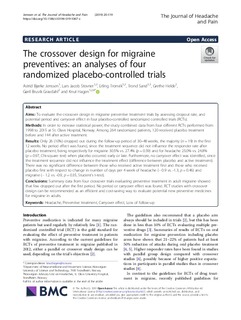| dc.contributor.author | Astrid Bjørke, Jenssen | |
| dc.contributor.author | Stovner, Lars Jacob | |
| dc.contributor.author | Tronvik, Erling Andreas | |
| dc.contributor.author | Sand, Trond | |
| dc.contributor.author | Helde, Grethe | |
| dc.contributor.author | Gravdahl, Gøril Bruvik | |
| dc.contributor.author | Hagen, Knut | |
| dc.date.accessioned | 2020-01-27T14:24:48Z | |
| dc.date.available | 2020-01-27T14:24:48Z | |
| dc.date.created | 2020-01-06T11:29:45Z | |
| dc.date.issued | 2019 | |
| dc.identifier.issn | 1129-2369 | |
| dc.identifier.uri | http://hdl.handle.net/11250/2638147 | |
| dc.description.abstract | Aims
To evaluate the crossover design in migraine preventive treatment trials by assessing dropout rate, and potential period and carryover effect in four placebo-controlled randomized controlled trials (RCTs).
Methods
In order to increase statistical power, the study combined data from four different RCTs performed from 1998 to 2015 at St. Olavs Hospital, Norway. Among 264 randomized patients, 120 received placebo treatment before and 144 after active treatment.
Results
Only 26 (10%) dropped out during the follow-up period of 30–48 weeks, the majority (n = 19) in the first 12 weeks. No period effect was found, since the treatment sequence did not influence the responder rate after placebo treatment, being respectively for migraine 30.5% vs. 27.4% (p = 0.59) and for headache 25.0% vs. 24.8% (p = 0.97, Chi-square test) when placebo occurred early or late. Furthermore, no carryover effect was identified, since the treatment sequence did not influence the treatment effect (difference between placebo and active treatment). There was no significant difference between those who received active treatment first and those who received placebo first with respect to change in number of days per 4 week of headache (− 0.9 vs. -1.3, p = 0.46) and migraine (− 1.2 vs. -0.9, p = 0.35, Student’s t-test).
Conclusions
Summary data from four crossover trials evaluating preventive treatment in adult migraine showed that few dropped out after the first period. No period or carryover effect was found. RCT studies with crossover design can be recommended as an efficient and cost-saving way to evaluate potential new preventive medicines for migraine in adults. | nb_NO |
| dc.language.iso | eng | nb_NO |
| dc.publisher | BMC (part of Springer Nature) | nb_NO |
| dc.rights | Navngivelse 4.0 Internasjonal | * |
| dc.rights.uri | http://creativecommons.org/licenses/by/4.0/deed.no | * |
| dc.title | The crossover design for migraine preventives: an analyses of four randomized placebo-controlled trials | nb_NO |
| dc.type | Journal article | nb_NO |
| dc.type | Peer reviewed | nb_NO |
| dc.description.version | publishedVersion | nb_NO |
| dc.source.journal | The Journal of Headache and Pain | nb_NO |
| dc.identifier.doi | 10.1186/s10194-019-1067-z | |
| dc.identifier.cristin | 1766704 | |
| dc.description.localcode | © The Author(s). 2019 Open Access This article is distributed under the terms of the Creative Commons Attribution 4.0 International License (http://creativecommons.org/licenses/by/4.0/) | nb_NO |
| cristin.unitcode | 194,65,30,0 | |
| cristin.unitcode | 1920,16,1,0 | |
| cristin.unitcode | 1920,16,0,0 | |
| cristin.unitcode | 1920,26,0,0 | |
| cristin.unitname | Institutt for nevromedisin og bevegelsesvitenskap | |
| cristin.unitname | Nasjonal kompetansetjeneste for hodepine | |
| cristin.unitname | Nevroklinikken | |
| cristin.unitname | Sentral stab | |
| cristin.ispublished | true | |
| cristin.fulltext | original | |
| cristin.qualitycode | 1 | |

